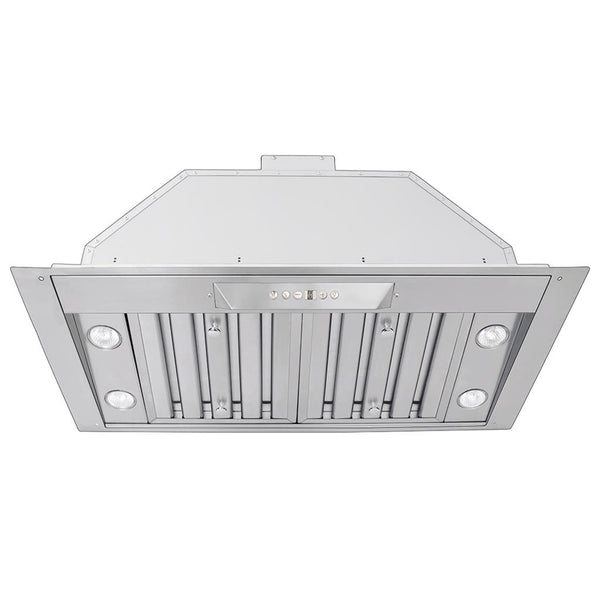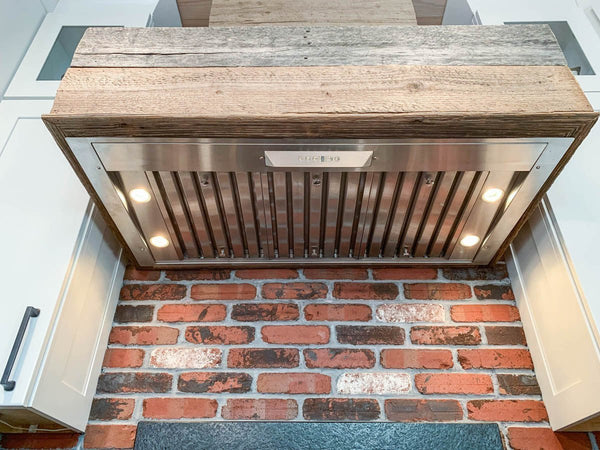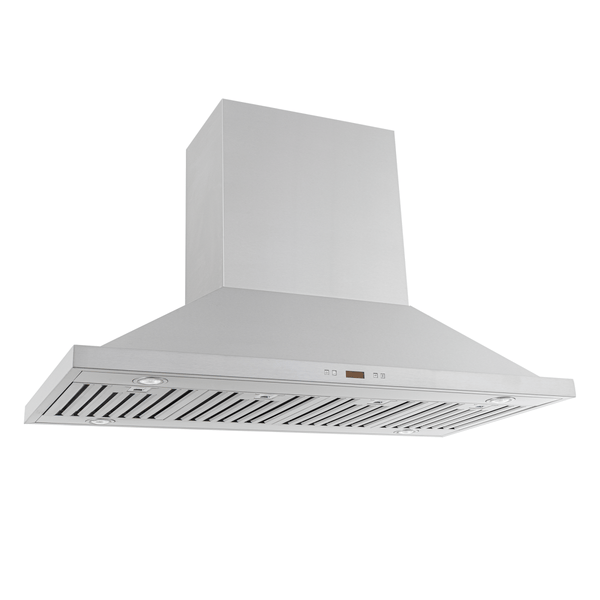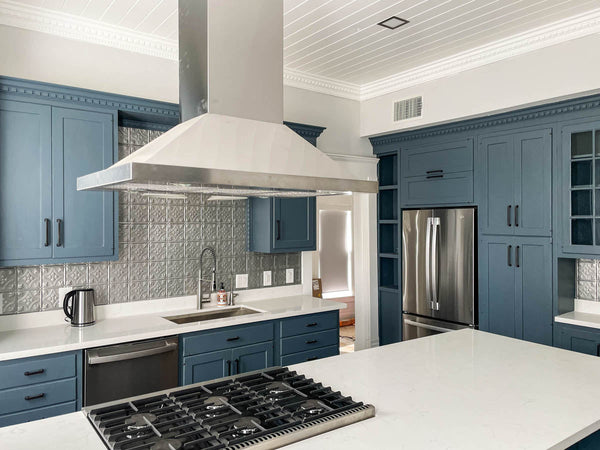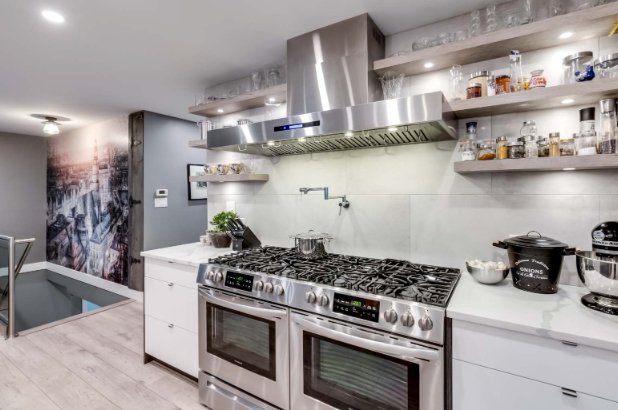Ensuring proper ventilation in your kitchen is crucial for maintaining good indoor air quality. Studies have shown that indoor air can often be more polluted than outdoor air, making it essential to prioritize effective exhaust systems. This quick guide will also help you understand the key elements of kitchen ventilation and avoid common pitfalls. But first, the ventilation options that aren't the best.
Ineffective Ventilation Options
Some ventilation designs appear sleek and modern, but fall short in functionality, leading to inadequate removal of cooking pollutants.
Slide-out Hoods

The compact, space-saving nature and design appeal of slide-out hoods don't make up for their lack of ability to do what you need them to do... capture and evacuate cooking emissions, especially for high-heat cooking. For optimal indoor air quality, dedicated range hoods with proper sizing and positioning are strongly recommended over slide-out models.
Inadequate Capture Area
Slide-out hoods typically do not extend far enough over the cooktop to provide sufficient coverage and capture area for smoke, vapors, and cooking odors. They often only cover a small portion of the burners, allowing emissions from the front burners (which tend to be the most powerful) to escape uncaptured.
Limited Coverage
Related to the capture area issue, slide-out hoods simply do not provide enough horizontal coverage across the entire cooktop. Their compact design means they cannot adequately encompass the full width and depth of the cooking surface.
Poor Evacuation
Even if the slide-out hood manages to capture some emissions, its internal fan and ductwork are usually undersized compared to dedicated range hood systems. This results in poor evacuation of the captured air, allowing smoke and odors to linger.
Cabinet Space Constraints
Slide-out hoods are integrated into kitchen cabinetry, which limits the space available for an adequately sized capture area and fan/ductwork. Their design is often prioritized for aesthetics over high-performance ventilation.
Designed for Light Cooking
While convenient for light cooking tasks, slide-out hoods are simply not equipped to handle the high heat, smoke, and grease output from serious cooking activities like stir-frying, searing, or grilling.
Downdraft Hoods

While downdraft hoods may seem sleek and unobtrusive, their design compromises make them ineffective at removing cooking contaminants from the air, especially during high-heat cooking activities. For optimal indoor air quality, traditional overhead range hoods are strongly recommended over downdraft systems. There are several reasons why downdraft hoods are generally not recommended as good options.
Poor Capture Ability
Downdraft hoods are designed to pull air down and away from the cooktop, which goes against the natural rise of smoke and cooking vapors. This makes it very difficult for them to effectively capture emissions, especially from powerful front burners.
Airflow Reversal
Since downdrafts reverse the airflow direction compared to traditional hoods, they struggle to pull in the smoke and vapors that rise upwards from the cooking surface. This inherent design flaw limits their capture efficiency.
Lack of Overhead Coverage
Unlike traditional range hoods that cover the entire cooktop from above, downdraft hoods have no overhead capture area. This means emissions can easily escape and spread throughout the kitchen before being pulled down.
Long Ductwork with Bends
Downdraft systems often require long ductwork runs with multiple bends and transitions to exhaust the air outside. These tortuous duct paths create significant airflow resistance and reduce overall ventilation performance.
Ineffective for Front Burners
Most cooktops have their highest BTU/power burners located at the front. Downdrafts, typically installed at the back of the cooktop, struggle immensely to capture emissions from these powerful front burners.
Island Cooktop Challenges
Downdrafts are commonly used with island cooktops for aesthetic reasons, but this setup exacerbates their capture issues since emissions can escape in all directions without an overhead hood.
Over-the-Range Microwaves

The allure of combined appliances fades when you realize their venting power can't kept pace with your cooking.
To maintain healthy indoor air quality and effectively remove cooking emissions, a dedicated range hood system, engineered specifically for superior ventilation, is strongly recommended over the limited exhaust capacity of over-the-range microwaves, which struggle to handle intense heat and fumes from modern high-BTU stoves and ranges.
Insufficient Exhaust Airflow (CFM)
Most over-the-range microwaves have exhaust fan ratings in the range of 300-360 CFM (cubic feet per minute). This airflow rate is generally inadequate for effectively removing smoke, vapors, and odors produced by modern high-BTU cooktops and ranges. Powerful gas ranges can output over 20,000 BTUs, requiring much higher CFM ratings (600 CFM or more) for proper ventilation.
Lack of Adequate Capture Area
OTR microwaves are designed with limited capture areas, as they are primarily intended for venting smaller volumes of steam and odors from basic microwave cooking. They often do not extend far enough over the cooktop to capture emissions from the front burners effectively, which tend to be the highest output and produce the most smoke and vapors.
Improper Positioning and Design
Over-the-range microwaves are typically positioned too high above the cooktop surface and lack the depth required for optimal capture and containment of cooking emissions. Their design prioritizes the microwave function over effective range ventilation, resulting in poor alignment with the cooktop burners and inefficient evacuation of smoke and vapors.
Slanted or Angled Designer Hoods

While slanted designer hoods can add a unique aesthetic touch to a kitchen, their form-over-function design often compromises their ventilation performance. Here are three good reasons why slanted designer range hoods may not be the best options for effective cooking ventilation:
Inadequate Capture Area
Many slanted designer hoods prioritize aesthetics over functional design. As a result, they often have a shallow capture area that fails to extend far enough over the cooktop surface. This limited coverage makes it difficult to effectively capture smoke, vapors, and odors, especially from powerful front burners.
Poor Capture Angle
Traditional range hoods are designed with a horizontal capture area directly above the cooktop. Slanted hoods, however, have an angled capture area that is less efficient at trapping rising cooking emissions. The slanted design allows more smoke and vapors to escape past the hood before being drawn in.
Insufficient Airflow
While some slanted hoods may have high CFM (cubic feet per minute) ratings, the angled design can disrupt smooth airflow and create turbulence. This can reduce the hood's ability to efficiently evacuate the captured emissions, leading to potential air quality issues within the kitchen.
Decorative Hoods - Be careful

When choosing or creating a stylish custom hood, it's crucial to prioritize functionality over aesthetics. Ensure that the hood extends far enough to adequately cover your entire cooking area, including the front burners.
Additionally, the blower should be powerful enough to effectively capture and remove cooking fumes, smoke, and odors. Ideally, the blower should be positioned strategically to capture the rising cooking exhaust efficiently.
Neglecting these practical considerations can lead to ineffective ventilation, leaving your kitchen filled with lingering smells and potentially hazardous air quality.
Strike a balance between style and performance to create a custom hood that not only enhances your kitchen's aesthetic but also provides optimal ventilation for a pleasant cooking experience.
Striking the Right Balance
Choosing the right ventilation means balancing aesthetics with performance, ensuring efficient pollutant capture and removal while cooking. This requires considering factors like vent size, power, and positioning to make sure that when you cook, your focus remains on creating flavorful dishes rather than worrying about air quality.
Understanding Airflow Rate (CFM)
The effectiveness of your range hood is measured in cubic feet per minute (CFM), indicating the volume of air it can extract in a minute. For example, a vent with a 600 CFM rating will move 600 cubic feet of air every minute, while a powerful 1200 CFM unit can expel an amount of air equivalent to that of a small room every minute.
If you have a very powerful exhaust system, you'll need to replenish the displaced air, typically through a makeup air system to balance the pressure.
We have a great in-depth article on CFM here if you would like to know more about it.
Capture Area: Size Matters
The capture area refers to the coverage area under the range hood where cooking exhaust is able to be captured by the hood and expelled from the cooking space. It's the hood's ability to effectively capture and contain cooking emissions, such as smoke, vapors, and odors. An inadequate or undersized capture area will allow these emissions to escape past the hood, leading them to linger in the home's indoor environment.
This is especially vital with high-powered front burners because a shallow or poorly designed hood could leave smoke wafting around your kitchen.
Ductwork Configuration
For efficient air evacuation, straight, short duct paths are preferable. The longer and more complex the pathway, with bends and turns, the less efficient your venting becomes.
Proper Duct Sizing: For new installations, it's generally advisable to install ducts that are 8 to 10 inches in diameter to avoid restricted airflow. Here is a great guide we wrote all about ductwork as well.
Placement Considerations
Positioning your cooking area against a wall simplifies venting and enhances efficiency. Wall placement simplifies the ductwork and improves the overall effectiveness compared to an island setup.
Key Takeaways
- Proper stove ventilation is crucial for healthy indoor air quality and requires effective CFM and hood capture size.
- Many popular ventilation designs prioritize form over function, leading to inadequate removal of cooking pollutants.
- Choosing the right ventilation means balancing aesthetics with performance, ensuring efficient pollutant capture and removal while cooking.
- Understand the importance of airflow rate (CFM), capture area, ductwork configuration, and ideal placement for optimal kitchen ventilation.
- Avoid ineffective options like downdrafts, slide-out hoods, over-the-range microwaves, and undersized decorative hoods.
By considering these essential factors, you can create a well-ventilated and comfortable cooking environment in your kitchen, ensuring that your focus remains on culinary creativity without compromising indoor air quality.
Other Articles
Determining the Ideal CFM for Your Outdoor Range Hood (From the Pros)
Does an outdoor kitchen need a vent hood?
Who to Hire for Flawless Outdoor Range Hood Installation
